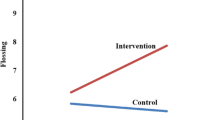Abstract
Habitual behaviors, such as problematic nail biting, are a common target for self-managed behavior-modification programs. The current self-experiment used self-monitoring in conjunction with a self-managed differential-reinforcement procedure for the treatment of problematic nail biting. A simple picture-comparison procedure allowed an independent observer to assist in monitoring treatment progress and outcomes and to ensure treatment integrity. Results provide support that the overall treatment package was successful in decreasing the occurrence of nail biting. Moreover, the treatment-integrity procedure enabled full-day monitoring to take place with limited requirement of a secondary observer.
Similar content being viewed by others
References
Allen, K. W. (1996). Chronic nailbiting: A controlled comparison of competing response and mild aversion treatments. Behavior Research and Therapy, 34, 269–272.
Baer, D. M., Wolf, M. M., & Risley, T. R. (1968). Some current dimensions of applied behavior analysis. Journal of Applied Behavior Analysis, 1, 91–97.
Ballinger, B. R. (1970). The prevalence of nail-biting in normal and abnormal populations. British Journal of Psychiatry, 117, 445–446.
Barmann, B. C. (1979). The use of overcorrection with artificial nails in the treatment of chronic fingernail-biting. Mental Retardation, 17, 309–311.
Christensen, A. P., & Sanders, M. R. (1987). Habit reversal and differential reinforcement of other behaviour in the treatment of thumb-sucking: An analysis of generalization and side-effects. Journal of Child Psychology and Psychotherapy and Psychiatry, 28, 281–295.
Christmann, F., & Sommer, G. (1976). Verhaltenstherapeutische behandlung des fingernägelbeißens: Assertives training und selbstkontrolle [Behavior therapy of fingernail-biting: Assertive training and self-control]. Praxis der Kinderpsychologie und Kinderpsychiatrie, 25, 139–146.
Dufrene, B. A., Watson, T. S., & Kazmerski, J. S. (2008). Functional analysis and treatment of nail biting. Behavior Modification, 32, 913–927.
Kazdin, A. E., & Bootzin, R. R. (1972). The token economy: An evaluative review. Journal of Applied Behavior Analysis, 5, 343–372.
Ladouceur, R. (1979). Habit reversal treatment: Learning an incompatible response or increasing subject awareness? Behavior Research and Therapy, 17, 313–316.
Libretto, S. V. (1999). Habit reversal treatment and nailbiting: Is awareness implicit in the competing response? Dissertation Abstracts International: Section B. Sciences and Engineering, 60 (3-B), 1305.
Peterson, A. L., Campris, R. L., & Azrin, N. H. (1994). Behavioral and pharmacological treatment for tic and habit disorders: A review. Journal of Developmental and Behavioral Pediatrics, 15, 430–431.
Roberts, S., & Neuringer, A. (1998). Self-experimentation. In K. A. Lattal & M. Perone (Eds.), Handbook of research methods in human operant behavior (pp. 619–655). New York, NY: Plenum Press.
Stokes, T. F., & Baer, D. M. (1977). An implicit technology of generalization. Journal of Applied Behavior Analysis, 10, 349–367.
Vargas, J. M., & Adesso, V. J. (1976). A comparison of aversion therapies for nailbiting behavior. Behavior Therapy, 7, 322–329.
Author information
Authors and Affiliations
Corresponding author
Additional information
The author thanks Dr. Claire St. Peter Pipkin for her helpful comments on earlier versions of this manuscript and Casey T. Kanala for aiding with participant observations and data collection.
Rights and permissions
About this article
Cite this article
Craig, A.R. Self-Administered Behavior Modification to Reduce Nail Biting: Incorporating Simple Technology to Ensure Treatment Integrity. Behav Analysis Practice 3, 38–41 (2010). https://doi.org/10.1007/BF03391763
Published:
Issue Date:
DOI: https://doi.org/10.1007/BF03391763




